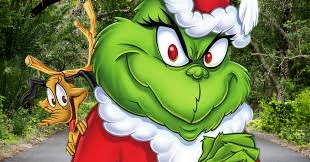
Few characters in the world of children’s literature and holiday storytelling are as iconic as the Grinch. Created by Dr. Seuss in his 1957 book, How the Grinch Stole Christmas!, the green, cantankerous character has captured hearts for decades with his curmudgeonly disdain for the holidays and his ultimate redemption through the power of community and kindness. Over the years, the Grinch has been reimagined and reinvented across different media, resonating with audiences in new and unexpected ways. This article delves into the origins of the Grinch, his journey from page to screen, and the enduring appeal of his story in the modern age.
The Origins of the Grinch
Dr. Seuss, whose real name was Theodor Seuss Geisel, wrote How the Grinch Stole Christmas! during a time of growing commercialization of the holiday season. The book, written in Seuss’s signature rhyming verse, tells the story of the Grinch, a grouchy, solitary creature who lives on Mount Crumpit, overlooking the cheerful town of Whoville. Disturbed by the Whos’ jubilant Christmas celebrations, the Grinch devises a plan to steal Christmas by taking all their decorations, gifts, and food.
However, he learns that the true spirit of Christmas is not tied to material possessions but to love and togetherness. The book became an instant classic, lauded for its clever wordplay, whimsical illustrations, and heartwarming message. The character of the Grinch, with his grumpy demeanor and eventual transformation, became an anti-hero that readers could empathize with, especially those feeling disenchanted with the pressures of the holiday season.

The First Major Adaptation: The 1966 Animated Special
The Grinch made his first leap from the pages of Dr. Seuss’s book to the screen in 1966 with an animated television special directed by Chuck Jones. Narrated by Boris Karloff, who also provided the voice of the Grinch, the special expanded on the book’s narrative while staying true to its themes and tone. The song “You’re a Mean One, Mr. Grinch,” performed by Thurl Ravenscroft, became an instant hit, encapsulating the Grinch’s mischievous and devious personality. The animation brought Dr. Seuss’s illustrations to life, making the Grinch’s sneaky antics and eventual transformation even more poignant. The 1966 special remains a staple of holiday programming and is often regarded as the definitive adaptation of the story.
A Live-Action Reimagining: Jim Carrey’s Grinch (2000)
In 2000, director Ron Howard brought How the Grinch Stole Christmas! to the big screen as a live-action feature film, with Jim Carrey portraying the titular character. This version expanded significantly on the original story, delving into the Grinch’s backstory and providing a more detailed look at the whimsical world of Whoville. Carrey’s performance, characterized by physical comedy and exaggerated expressions, earned both praise and critique, but his interpretation of the Grinch undeniably brought a new dimension to the character.
The film’s production design was a marvel, bringing Dr. Seuss’s imaginative illustrations to life with elaborate sets and costumes. While some viewers found the darker tone and expanded narrative a departure from the simplicity of the original, the movie introduced the Grinch to a new generation, grossing over $345 million worldwide and solidifying its place as a holiday favorite.

A Modern Animated Take: The Grinch (2018)
In 2018, Illumination Entertainment, the studio behind Despicable Me and Minions, released a new animated adaptation titled The Grinch. Voiced by Benedict Cumberbatch, this version of the Grinch presented a slightly softer and more comedic interpretation of the character. The film updated the story for contemporary audiences, incorporating modern humor and a more fleshed-out backstory for the Grinch’s motives. While some critics argued that the 2018 adaptation lacked the sharp edge of the original and previous versions, it was widely praised for its vibrant animation and family-friendly approach. The movie’s soundtrack, featuring artists like Tyler, the Creator, also added a fresh and modern twist to the holiday classic.
The Enduring Appeal of the Grinch
So, what makes the Grinch such an enduring figure in holiday storytelling? One reason lies in the universality of his journey. The Grinch’s story is one of redemption and self-discovery—themes that resonate deeply with audiences of all ages. At its core, the tale is a reminder that the holiday season is about more than gifts and decorations; it’s about connection, generosity, and the intangible magic of togetherness. Moreover, the Grinch’s character allows for multiple interpretations. He can be seen as a symbol of holiday cynicism, a reflection of the alienation many feel during the festive season, or even a critique of consumerism. This flexibility makes him a relatable figure who can adapt to different times and cultural contexts.

Cultural Impact and Legacy
Beyond the adaptations, the Grinch has permeated popular culture in countless ways. His distinct green visage and signature scowl have become synonymous with holiday mischief, and phrases like “Grinch” and “Grinchy” are now part of the vernacular, often used to describe someone lacking holiday spirit. The Grinch’s story has also inspired various parodies, merchandise, and themed events, including Grinch-themed holiday attractions at theme parks. The character’s enduring popularity ensures that he remains a central figure in holiday celebrations worldwide.
Conclusion
Dr. Seuss’s How the Grinch Stole Christmas! is more than just a children’s book; it’s a timeless story that has evolved and adapted to remain relevant in every era. Whether through the classic 1966 animated special, Jim Carrey’s larger-than-life portrayal, or Benedict Cumberbatch’s modern interpretation, the Grinch’s journey from a bitter recluse to a warm-hearted member of the community continues to inspire and entertain. As we revisit this holiday classic each year, it serves as a poignant reminder of the true spirit of the season. The Grinch may start out stealing Christmas, but he ultimately gives us a gift far more valuable: the lesson that love, kindness, and togetherness are what truly make the holidays special.





3 thoughts on “Dr. Seuss’ The Grinch: A Holiday Classic Reimagined”